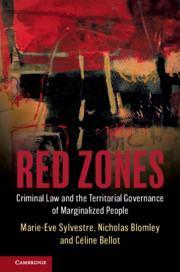Book contents
- Red Zones
- Red Zones
- Copyright page
- Dedication
- Contents
- Figures
- Maps
- Tables
- Acknowledgments
- Cases
- Legislation
- 1 Navigating the Territories of the Law
- Part I Foundations
- Part II Expansion
- Part III Territorialization and Its Consequences
- 6 Territorializing: How Legal Territory Is Made and Justified
- 7 Conditional Life inside the Red Zone
- 8 Red Zoning Politics
- Conclusion
- Bibliography
- Index
6 - Territorializing: How Legal Territory Is Made and Justified
from Part III - Territorialization and Its Consequences
Published online by Cambridge University Press: 06 February 2020
- Red Zones
- Red Zones
- Copyright page
- Dedication
- Contents
- Figures
- Maps
- Tables
- Acknowledgments
- Cases
- Legislation
- 1 Navigating the Territories of the Law
- Part I Foundations
- Part II Expansion
- Part III Territorialization and Its Consequences
- 6 Territorializing: How Legal Territory Is Made and Justified
- 7 Conditional Life inside the Red Zone
- 8 Red Zoning Politics
- Conclusion
- Bibliography
- Index
Summary
Chapter 6 explores the institutional context in which the work of territorialisation is performed, its rationale, and its relational logic of cutting and joining. It first introduces the context in which conditions of release are imposed and how legal actors practically choose and design these conditions, relying on internalized institutional norms and practices as well as information on the interactions between the accused and the spaces where the offence is (allegedly, at first) committed. The chapter then presents the competing State interests pursued by different legal actors during the criminal process, focusing particularly on the shifting rationalities of bail from ensuring the accused’s presence in court and preventing crime, to therapeutic and law enforcement.This chapter illustrates how legal actors mobilize both space and time to achieve their different goals.
Keywords
- Type
- Chapter
- Information
- Red ZonesCriminal Law and the Territorial Governance of Marginalized People, pp. 137 - 162Publisher: Cambridge University PressPrint publication year: 2020

